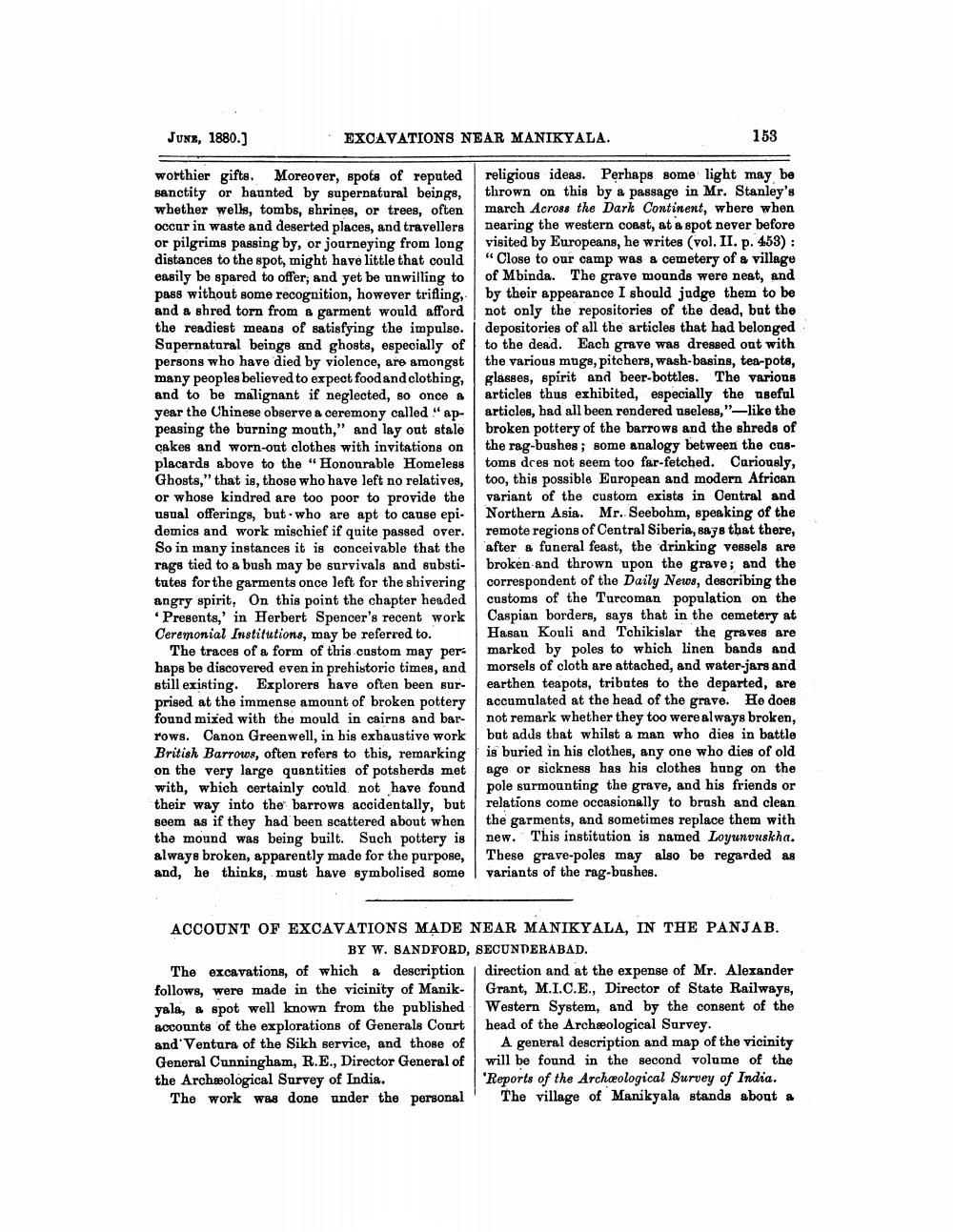________________
JUNE, 1880.)
EXCAVATIONS NEAR MANIKYALA.
153
worthier gifte. Moreover, spots of reputed religious ideas. Perhaps some light may be sanctity or haunted by supernatural beings, thrown on this by a passage in Mr. Stanley's whether wells, tombs, shrines, or trees, often march Across the Dark Continent, where when occur in waste and deserted places, and travellers nearing the western coast, at a spot never before or pilgrims passing by, or journeying from long visited by Europeans, he writes (vol. II. p. 453): distances to the spot, might have little that could | “Close to our camp was a cemetery of a village easily be spared to offer, and yet be unwilling to of Mbinda. The grave mounds were neat, and pass without some recognition, however trifling, by their appearance I should judge them to be and a shred torn from a garment would afford not only the repositories of the dead, but the the readiest means of satisfying the impulse. | depositories of all the articles that had belonged Supernatural beings and ghosts, especially of to the dead. Each grave was dressed out with persons who have died by violence, are amongst the various mugs, pitchers, wash-basins, tea-pots, many peoples believed to expect food and clothing, glasses, spirit and beer-bottles. The various and to be malignant if neglected, so once a articles thus exhibited, especially the useful year the Chinese observe a ceremony called "ap- articles, bad all been rendered useless,"-like the peasing the burning mouth," and lay out stale broken pottery of the barrows and the shreds of cakes and worn-out clothes with invitations on the rag-bushes; some analogy between the cusplacards above to the "Honourable Homeless toms does not seem too far-fetched. Curiously, Ghosts," that is, those who have left no relatives, too, this possible European and modern African or whose kindred are too poor to provide the variant of the custom exists in Central and usual offerings, but who are apt to cause epi. Northern Asia. Mr. Seebohm, speaking of the demics and work mischief if quite passed over. remote regions of Central Siberia, says that there, So in many instances it is conceivable that the after a funeral feast, the drinking vessels are rags tied to a bush may be survivals and substi- broken and thrown upon the grave; and the tutes for the garments once left for the shivering correspondent of the Daily News, describing the angry spirit. On this point the chapter headed customs of the Turcoman population on the
Presents,' in Herbert Spencer's recent work Caspian borders, says that in the cemetery at Ceremonial Institutions, may be referred to. Hasan Kouli and Tchikislar the graves are
The traces of a form of this custom may per- markod by poles to which linen bands and haps be discovered even in prehistoric times, and morsels of cloth are attached, and water jars and still existing. Explorers have often been sur- earthen teapots, tributes to the departed, are prised at the immense amount of broken pottery accumulated at the head of the grave. He does found mixed with the mould in cairns and bar- not remark whether they too were always broken, rows. Canon Greenwell, in his exhaustive work but adds that whilst a man who dies in battle British Barrows, often refers to this, remarking is buried in his clothes, any one who dies of old on the very large quantities of potsherds met age or sickness has his clothes hung on the with, which certainly could not have found pole surmounting the grave, and his friends or their way into the barrows accidentally, but relations come occasionally to brush and clean seem as if they had been scattered about when the garments, and sometimes replace them with the mound was being built. Such pottery is new. This institution is named Loyunvuskha. always broken, apparently made for the purpose, These grave-poles may also be regarded as and, he thinks, must have symbolised some variants of the rag-bushes.
ACCOUNT OF EXCAVATIONS MADE NEAR MANIKYALA, IN THE PANJAB.
BY W. SANDFORD, SECUNDERABAD. The excavations, of which a description direction and at the expense of Mr. Alexander follows, were made in the vicinity of Manik- Grant, M.I.C.E., Director of State Railways, yala, a spot well known from the published Western System, and by the consent of the accounts of the explorations of Generals Court head of the Archeological Survey and Ventura of the Sikh service, and those of A general description and map of the vicinity General Cunningham, R.E., Director General of will be found in the second volume of the the Archeological Survey of India.
"Reports of the Archæological Survey of India. The work was done under the personal The village of Manikyala stands about a




